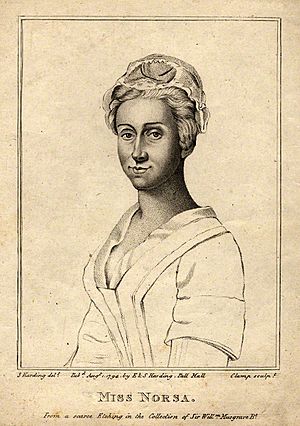Hannah Norsa facts for kids
Hannah Norsa (born around 1712, died August 28, 1784) was a talented English Jewish actress and singer. She became very famous after starring in a popular play called The Beggar's Opera in 1732. Later, she lived with Robert Walpole, 2nd Earl of Orford, who was the son of a powerful former Prime Minister.
Early Life and Stage Career
Hannah Norsa was the daughter of Issachar Norsa, who ran an inn in London. Her family was Italian Jewish and came from a city called Mantua.
Hannah made a huge splash when she first appeared on stage. This happened on December 16, 1732, at the Covent Garden Theatre. She played the part of Polly Peachum in a new showing of The Beggar's Opera. People loved her performance!
Over the next few years, Hannah took on many main roles in operas. She sang in works by composers like Johann Ernst Galliard. In 1733, she also performed in another play by John Gay called Achilles. Hannah wasn't just a singer; she also acted in plays that didn't involve singing, such as The Beaux' Stratagem and The Orphan.
Life with the Earl of Orford
Around 1736, Hannah Norsa began a new chapter in her life. She started living with Robert Walpole, who was the son of the former Prime Minister, Robert Walpole. Robert Walpole's own marriage had ended, and Hannah moved in with him.
When Robert became the Earl of Orford in 1745, they moved to a grand house called Houghton Hall in Norfolk. People who knew Hannah at the time spoke highly of her. A local clergyman's wife wrote that Hannah was "a very agreeable Woman" and behaved very well. She was well-liked and had a lot of influence at Houghton Hall. Hannah and Robert had a son together in 1740, but he sadly passed away when he was young.
Hannah's story shows how someone from the stage could rise in society. She stayed with Robert Walpole until he died in 1751. It seems she even helped him with his large debts.
Later Years and Legacy
After Robert Walpole's death in 1751, Hannah Norsa was cared for by John Rich. He was the person who produced The Beggar's Opera, the play that made her famous.
When Hannah Norsa died in Kensington on August 28, 1784, she was quite wealthy. She left behind a good amount of money, about £3,400, which was invested in government bonds. She was buried at St Mary Abbots church in Kensington.


